Excerpts from Jim Conrad's
Naturalist Newsletter
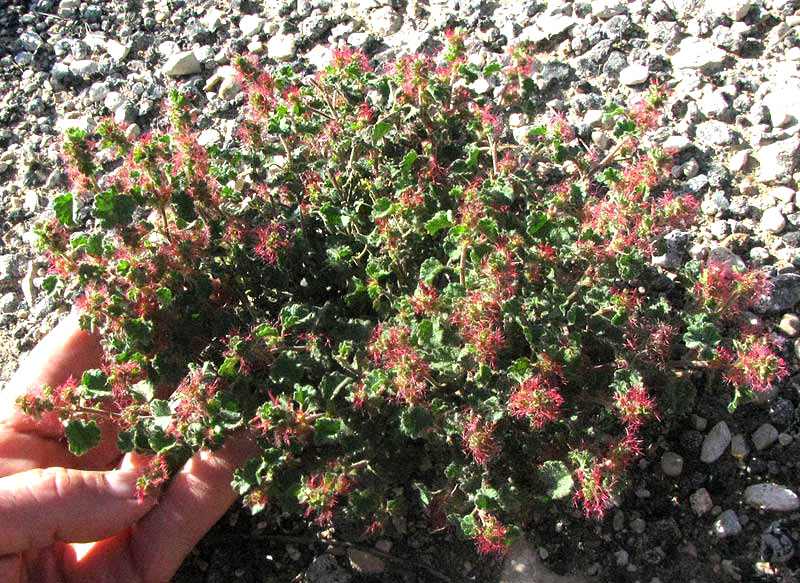
from the October 27, 2013 Newsletter issued from the Frio Canyon Nature Education Center in the valley of the Dry Frio River in northern Uvalde County, southwestern Texas, on the southern border of the Edwards Plateau; elevation ~1750m (~5750 ft); N29.62°, W99.86°; USA
COPPERLEAF
On a dazzlingly sunny, skin-blistering day I biked down Ranch Road just to the south when in blindingly white gravel along the road a bread-loaf-size mound of vegetation sprinkled with fuzzy red little somethings turned up, as shown above.
Up close the little mound revealed itself as composed of many short, leafy branches bearing hairy, roundish leaves with scalloped margins, and the red things turned out to be flowering heads, seen below:
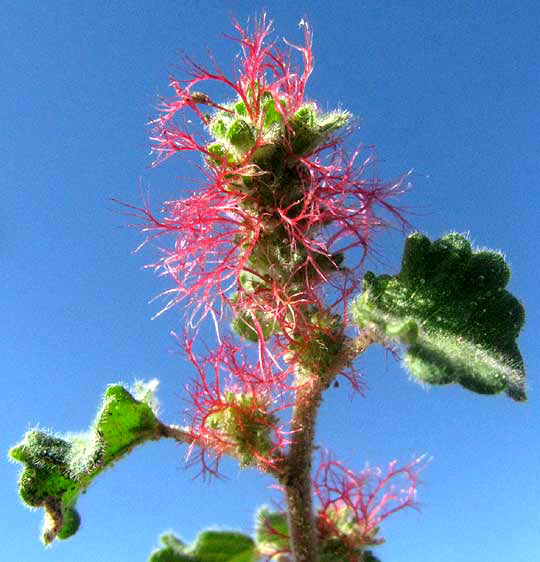
Isolating just one flower, I could see that the branched, reddish filaments were styles atop a female flower's ovary, with no male stamens in view, as shown below:
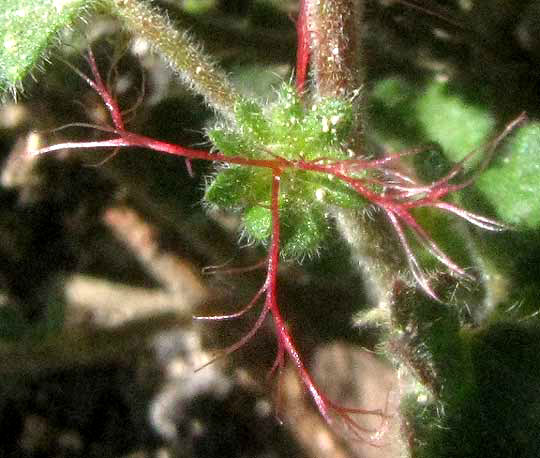
Wanting to see male flowers I examined the little plant -- which arose from a woody base despite the herbaceous-seeming stems -- but none were found.
Back on the bike, a few miles farther down the road a whole colony of the plant appeared, and this time there were plants with male flowers, shown below:
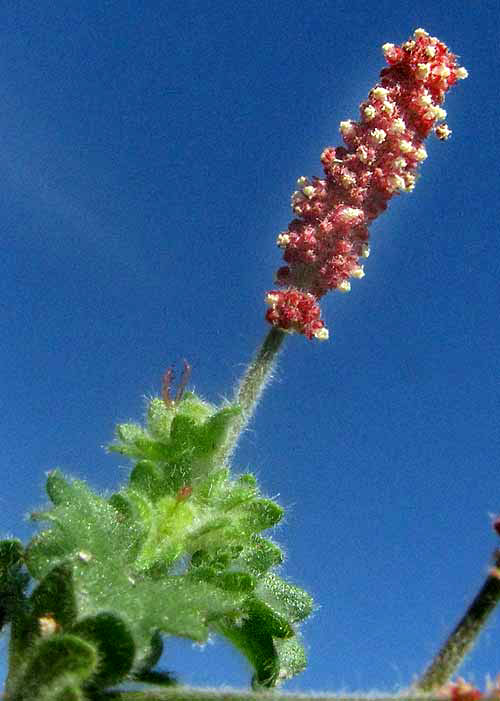
Though I'd never seen this species, I was familiar with its genus, which was Acalypha of the Poinsettia or Euphorbia Family, the Euphorbiaceae. Acalypha species are recognized by having unisexual flowers like these; often species in the genus are referred to as copperleafs. It's a big genus, with over 450 species known worldwide, and they're often weedy and commonly occurring, so it's a good genus to know.
Our roadside one turned out to be what's usually called Round Copperleaf, though nurseries like to call it Raspberry Fuzzy because that probably sells better and it's easier to remember. It's ACALYPHA MONOSTACHYA.
At the bottom of the spike of male flowers in the last picture you can see two female flowers with red style arms that are less spectacular than those in the first picture. Apparently this species can have flowers of both sexes on the same plant, though each plant tends to be predominantly male or female. This is worth noting because in southern Texas there's a very similar species, Acalypha radians, which the literature says has just one gender of flower per plant. Its leaves also are more deeply divided than ours.
The online Biblioteca Digital de la Medicina Tradicional Mexicana, which calls our plant Hierba del Cáncer, or Cancer Herb, reports people in central Mexico using a "tea" of the plant to wash boils, plus the tea can be gargled for a sore throat.
Round Copperleaf mostly occurs in arid northern Mexico's Chihuahuan Desert, and extends into the US only in southern Texas.
Doves, bobwhites and other small birds eat the seeds, and deer browse on the foliage.
entry dated June 16, 2022, issued from near Tequisquiapan; elevation about 1,900m, (6200 ft), ~N20.57°, ~W99.89°; Querétaro state, MÉXICO
ROUND COPPERLEAF
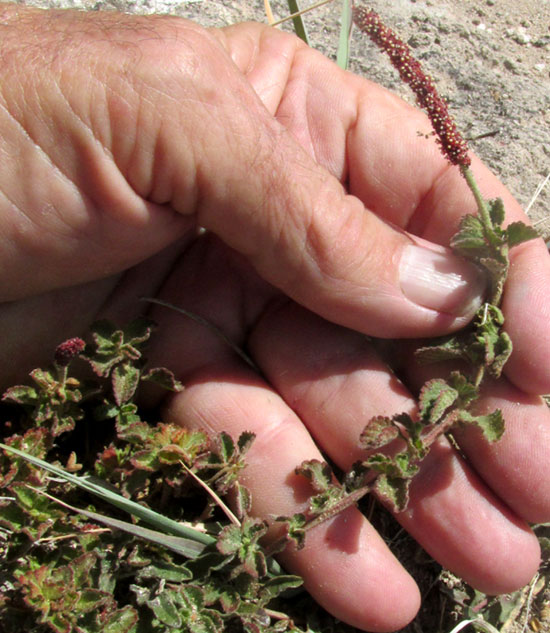
In the middle of a dirt road across a hilltop so eroded from overgrazing that there was hardly any soil left, just the area's usual rock-like compacted sediment from the surrounding rhyolite hills, two small patches of vegetation somehow were surviving. Above you see a spikelike inflorescence of a plant in one tuft.
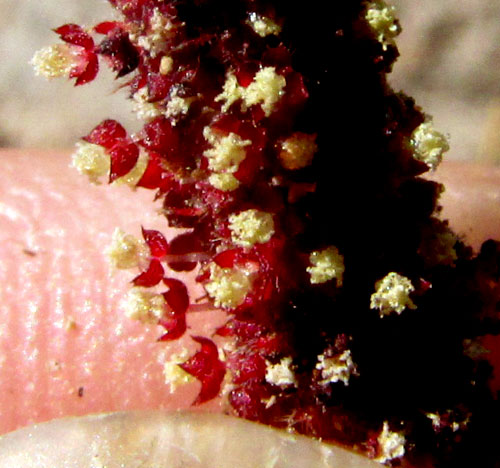
Up close, the hand lens showed that the yellowish dots in the red inflorescence were crammed-together tufts of tiny, pollen-producing, unisexual male flowers. Each flower consisted of several tight clusters of stamens arising from the center of a dark red calyx consisting of four distinct sharp-tipped sepals, and the calyx itself stood upon its own slender, pink stem, or pedicel. It was a very elegant arrangement to find in such a desolate, windswept place, and all those male flowers held above the plant must have done a good job spreading their pollen into the wind.
The leaves were about thumbnail size, with reddish-rimmed, crenulated margins, and the leaves and stems were thickly covered with stiff, white hairs that collected rock particles among them, as seen below:
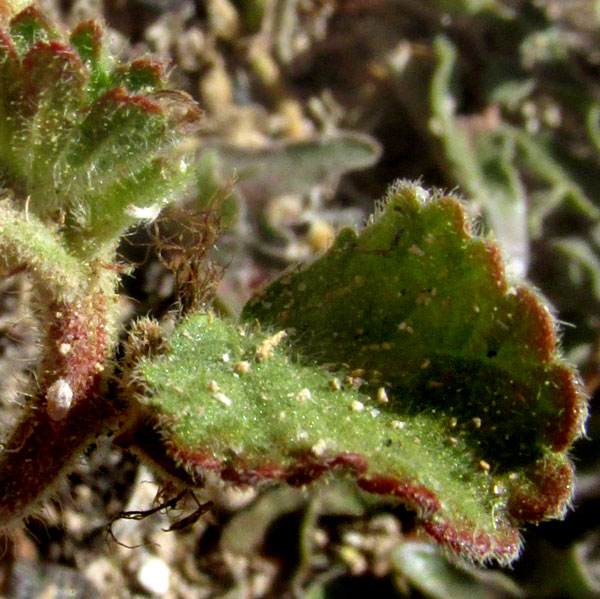
While taking that picture I noticed the long, brown tuft of threadlike items emerging from somewhere behind the leaf's base. These were surely old, dried-up styles from a female flower. Others were found peeping from close clusters of younger leaves at the tip of emerging stems, as shown below:
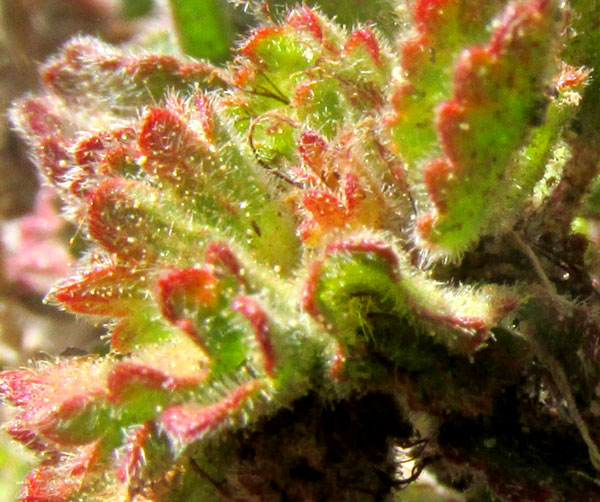
Finally, here's what the small plant patches looked like in the much eroded road:
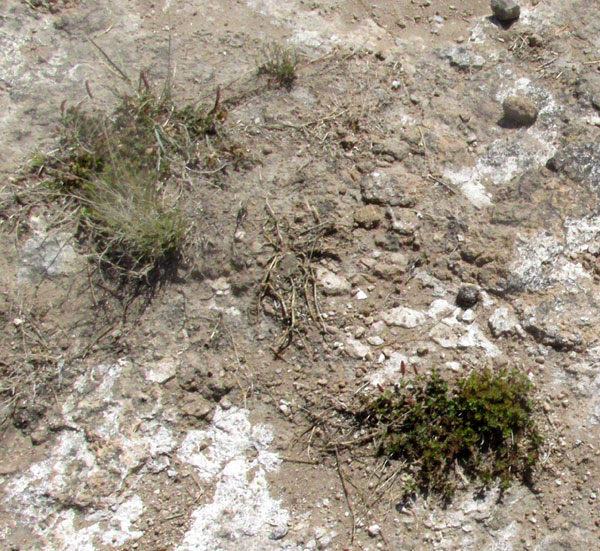
Mostly in the tropics and subtropics, this is a commonly encountered kind of plant, often known as copperleafs, the genus Acalypha in the Euphorbia Family, the Euphorbiaceae. About 450 species of them occur worldwide. Some of them are favorite garden plants because the often-reddish inflorescences can be attractively long and dangling.
It wasn't until "doing the botany" that I realized that up in Texas we'd already encountered this species {report at top of page}. Those plants, however, weren't in such a challenging habitat, had their male and female flowers somewhat differently arranged, and the vegetative parts weren't nearly as compactly arranged for hot, dry winds as were these plants'. Our plant is the Round Copperleaf, ACALYPHA MONOSTACHYA, known to produce its flowers in male, female and bisexual inflorescences, with all-male, all-female, and bisexual plants being possible.
In Mexico a name for the plant often used is Hierba del Cáncer, more or less "Cancer Herb." Gerardo García Regalado's Plantas Medicinales de Aguascalientes -- Aguascalientes being a state in central Mexico -- I read that traditionally the whole plant without its roots is brewed to make a tea to deal with cancer. No lab studies turn up on the Internet supporting this use. However, a 2009 study by Karla Lizbeth Macías S. and others, entitled "Evaluación de plantas tradicionalmente utilizadas en la desinfección de heridas" found that extracts of the plant show strong antibacterial activity, so they can be used effectively to wash wounds and skin infections.